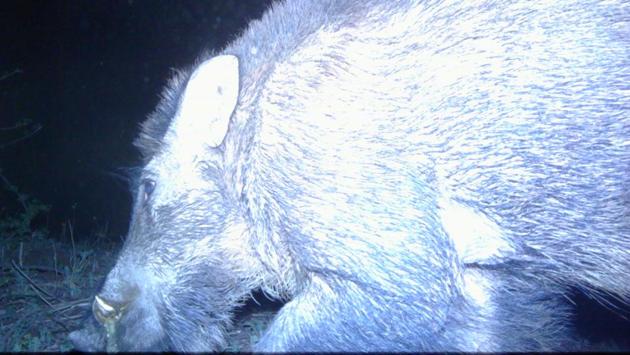Wildbuzz | Wildly boring at Siswan
During subsequent explorations of Siswan during day and night, I came across evidence of a healthy population of boars and dug up areas signifying boar feeding.
The first time I witnessed the extent of a wild boar’s omnivorous appetites was under a cold, ethereal sunset cast over the Siswan Dam jungles in late December in 2011. The pugnacious blighter was enjoying a rotting buffalo calf while we were engaged 20 yards away in taking Plaster of Paris casts of a massive leopard’s pugmarks with a Punjab Forest and Wildlife Preservation department team.

During subsequent explorations of Siswan during day and night, I came across evidence of a healthy population of boars and dug up areas signifying boar feeding. To my delight, the Wildlife Institute of India (WII), Dehradun, conducted a survey of these jungles in May 2017 deploying 40 camera traps. The WII study validated my field assessments.
I sought counsel from renowned WII field biologist Dr Bivash Pandav, who had conducted the pioneering Siswan study. Dr Pandav told me: “Siswan jungles are one of the most productive wildlife habitats of the Shivalik range.’’ The boars at Siswan access roots, tubers, carrion and insects as food, with occasional indulgence in a perennial wild grass, which is the principal fodder for sambars.
“Yet, boars will foray from the Siswan jungle for crop depredation at night as crops are very nutritious and are just as tempting for boars as ‘rasgullas’ are for humans. However, the extent of crop depredation is exaggerated because of perceptional bias. In our study in Uttarakhand, we found that actual crop damage by boars was less than 10% of farmers’ claims,’’ said Dr Pandav.
Boars raid maize fields and, occasionally, ripening grains in Siswan’s peripheral villages. However, farmers report that sambars/neelgais cause more damage than these arch villains.

THE POPPY’S WILL
Those fond of nurturing red poppies in their gardens will testify that these are not good cut flowers. The stem is long and fragile and the passionate red bloom virtually collapses when plucked and placed in an elegant vase. During the course of my two reporting tenures in Kashmir (1997-99 and 2004), I would bring back to my room in Srinagar bunches of wild large-mouthed poppies (Papaver macrostomum) from the sparkling summer fields of Budgam and Pampore. But alas, these Kashmir poppies seemed to wail and wilt within hours of my murderous separation of the stems from their beloved earth.
However, nature’s individual specimens can buck the trend just as human mavericks. During our family’s recent summer retreat to a resort short of Manali, I came across a lone wild poppy flaming like a lighthouse on the banks of the Beas. The resort was so located that its meadowy, bloom-dotted lawns dipped to the raging river. Perhaps, as I imagined, the insects and birds used the lone poppy as a navigational aid to negotiate the river’s spray and leaping turbulence and reach luxurious terra firma!
One morning of our stay, the bloom was weeded out and tossed into the Beas by the resort’s gardener. It was swept by the current but got lodged amid a waterfall of rocks. By a quirk of nature, neither did the stem snap nor did the adrift bloom shed a single petal to the water’s relentless, pounding urge. I waded into the silvery currents, rescued the limp bloom and took it back to our room. A small vase with a cut rose served as an emergency ward for the poppy. To my surprise, the poppy recovered quickly from the Beas battering. The green stem sprang straight up, petals opened like arms outstretched and stamens were eyes twinkling with warm smiles.

PLUCKY LITTLE LIZZIE
The rains bring with them the critters, which give us the jitters. Hardly have we settled down to the comfort of our car seats, and we find a lizard hatchling perched on our seat belts, cowering under the seats or slithering icily, though innocently, over our ankles.
Lizzie moms find the car’s dark, undisturbed recesses good for laying eggs, timed to hatch with the abundance of insect prey spawned by the rains.
While driving back from the Chandigarh Golf Club during the night of July 7, one such hatchling surfaced on my car’s windscreen. It clung on for dear life during the 3-km drive home. I observed the little lizzie’s heart thumping, the expression traumatised and bewildered as any innocent human kid would be if thrust by misfortune into a similar cliffhanger.
On reaching home, I nudged the plucky lizzie kid off the windscreen and towards a wall of our house, where I knew she or he would find a crevice for shelter. It would grow into a ‘guardian dragon’ that would slay mosquitoes, cockroaches, flying termites, among others, and in turn spawn a clan studded with sound survivor genes.
Lizards are non-venomous and are biological pest control agents par excellence. Only fault? They ain’t good looking!
vjswild1@gmail.com



